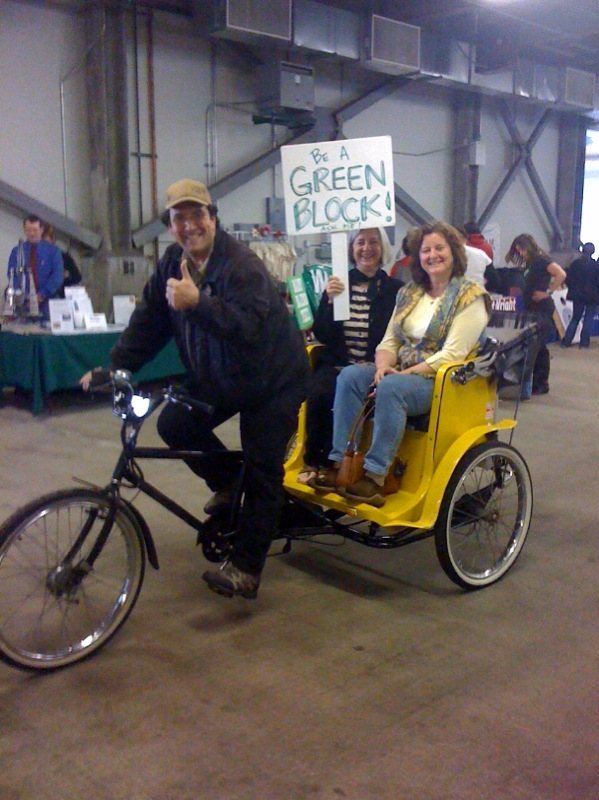A discussion with Dorie Blesoff and Margot McMahon written by Amy Boruta
Turn your block into a "green block"
Do you swear by your rain barrel or push mower and find yourself encouraging your neighbors to use one as well? You may be interested in turning your block into a ‘green block’. Dorie Blesoff and her neighbors had these conversations and began to turn their block green in 2006. The green block is a group of neighbors who work together to reduce their carbon footprint, in specific ways, over time. Dorie Blesoff and Margot McMahon share their experience with reducing their carbon footprint one block at a time.
During a Block Party in August 2006, Dorie and a small group of neighbors sat around late at night commenting on how much the movie "Inconvenient Truth" had impacted them. Dorie explained that the question soon arose, "What will we do about the fact our lifestyles are largely driving the huge carbon footprint made by the US?”
Build momentum through establishing seasonal projects
Dorie and her neighbors were active in the 1970's around environmental issues and they never lost their concern. They committed to researching, thinking, meeting and coming up with ideas for their block. They visited Green Technology Center, Green Depot, became familiar with Green Home Experts, and attended Green Tuesdays at the Library.
Soon their monthly meetings grew to 8 households and built momentum through establishing seasonal projects and providing additional green education. Since 2006, the block focuses around several areas: Zero Waste Block Parties, raising gardens in the summer (and Margot in the winter), encouraging their kids to think of ways to reduce carbon footprints and continuing to network with other organizations in the Village.
Block level initiatives intersect with village-level initiatives to speed change
Every single household participates in some way to reduce their carbon footprints. One might raise their own garden, another might mow the lawn with a push mower, another might can their own tomatoes, several might have compost bins, another might walk with their kids to the Farmer's Market in the summer, etc. They contribute some of their successes to the Village of Oak Park. Margot stated, “we are delighted to be a part of Oak Park that has met this grass roots movement with LEED certified buildings, brick streets, renewable sourced electric supply, support of a comprehensive village-wide plan to change.” They feel that their original concept of changing one block then another, then the whole village to reduce their carbon footprint has happened in a few short years because of the bottom up movement intersecting with the Village's top down movement. Margot feels that other towns can use our Village as an example of a community on various levels changing quickly. It is what the ‘green block’ envisioned years ago and while the process has no end, they believe that huge strides have taken place.
Green Block show-n-tell
The ‘green block’ recruits more participation through regular emails to the neighbors as well as word of mouth at block parties and their social gatherings on the block. The ‘green block’ continues to encourage the wider community to participate in this initiative as well. Residents of the ‘green block’ can be found attending many events to share their story through their show-n-tell book. They also share their Household Survey, which is distributed each year at the August Block Party, to show what has been improved. The ‘green block’ residents view networking with others in Oak Park and River Forest as important to share new ideas.
Inspiring one another
Dorie is most proud of how many people on the block participate in some way. Margot added, “We came together to inspire each other to change faster in reducing oil dependency and CO2 emissions enabling the earth to heal”. The ‘green block’ encourages others to find a community in their neighborhood, faith-based organization, or book group to support faster individual lifestyle change to lower carbon footprint. The neighbors have supported each other in changing faster than any individual would have on their own. “It's not about buying solar panels or purchasing things to 'go green’ but about walking more, shopping locally, growing backyard gardens and retaining water from run off,” Margot adds, “we are about simplifying our lives and reducing our energy use to help the climate change.”
Make it easy to try new things with a support system
At times it is difficult to maintain the momentum and find new ways for people to be involved. Dorie would suggest that others start small, focus on new projects each season, and make things easy for people to try new approaches with a support system.
Dorie lists ideas for those interested in implementing this ‘green block’ initiative:
Rain barrels to water lawns
Push mower or electric mower
Mulch leaves in fall instead of raking them for pick-up
Buy local and organic food from Farmer's Market or CSA or Irv & Shelly's Fresh Picks
Zero Waste Block Parties twice a year
Gardens with native plants and/or vegetables
Shop at Farmer's Markets - summer and winter
Walk, ride bikes, use the el - instead of cars
Rehab using green materials and building techniques
Fix up faulty insulation
Plant new trees
Install a compost bin and/or worm bin
If you would like to learn more about the ‘green block’ or the zero-waste block party, you can contact Dorie Blesoff at dorieblesoff1@comcast.net or Margot McMahon at mmcm310@comcast.net.



